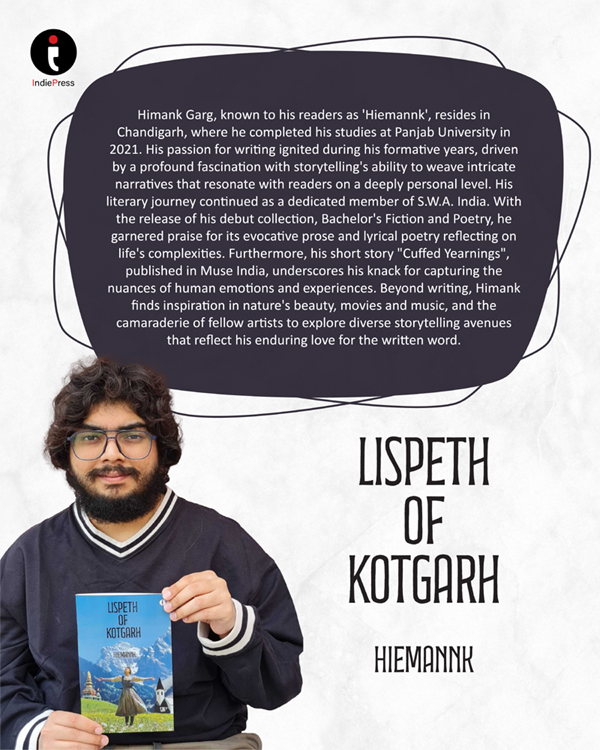1. What inspired you to write this particular book, and how did the idea for the story come to you?
This play was an undertaking between the History Association of DAVC, Chandigarh and myself, under the guidance of Dr. Manpreet Kaur. We were incredibly fascinated with the apparent rarity of this tragic love story from a postcolonial perspective where a native girl assertively defies colonial understanding of interpersonal relationships with the colonizers. Rudyard Kipling’s original short story – that is the source behind this work – allowed us to fill in many blanks between the psycho-cultural collision of worlds that were poles apart. Here, I have also tried to emulate Kipling’s own underlying affinity with the Indian culture at large through the eyes of his protagonist that offers a fresh and possibly intriguing take on the story.
2. Can you share some insights into your writing process? Do you follow a specific routine or have any unique rituals that help you get into the creative flow?
At the time when I wrote this play, it was no mean feat. Starting off with a structural translation of the original story into a play, it was a trite eight-pages long English simulacrum. Eventually, the idea to embellish an imagined Indianness of the times took root and thus, I was able to weave the narrative in seven months before the eventual staging of the play in February, 2019. I believe that a writer should strive to be clear about the outlines of an ending and a desired effect to deliver an impactful work, which is why we made sure to not overstay our welcome by ensuring a brisk progression of the play.
3. The characters in your book are quite distinct and memorable. Are they based on real people, or did they evolve purely from your imagination?
Apart from Kipling in the play, everybody else is either a carryover from his short story or a fictional interjection; the latter holds particularly true for almost every Indian character. As for
Kipling, my idea was to contrast him with his own work by reflecting upon his days as a young journalist in colonial Punjab, a person in whom the supremacy of the Empire was tantamount to his curiosity and zeal to experience the native realities.
4. Your book delves into specific themes. What motivated you to explore this theme, and what messages or discussions do you hope readers will take away from your work?
This work is undoubtedly a postcolonial reimagination. However, I think what primarily drives the narrative are the notes of tragedy in being star-crossed lovers against a monolithic social norm,resulting in the aloofness of one’s identity that women, in particular, face in the maelstrom of society, tradition, and religion. I would, as an artist, deeply appreciate the readers’ mindfulness of looking beyond the walls we inherit in order to bridge the ever-increasing chasms amongst us.
5. The world-building in your novel is incredibly rich and immersive. How did you go about creating the setting, and did you draw inspiration from any real-world locations or historical events?
For the intent of staging, it was next to impossible to accommodate the locations in which the story unfolds and thus, a reliance on simply mentioning them and keeping the action bound to a singular locale was the prudent alternative. Regardless, the narrative takes inspiration from colonial Kotgarh in the period between 1820 to 1888 (the latter being the year of publication of the source material by Rudyard Kipling) along with taking some creative license in filling the interpretive gaps of the subsequent culture.
6. As a writer, how do you balance the need for originality with the expectations of the genre? Were there any challenges in putting your unique spin on familiar elements?
I must admit, it is a great challenge keeping up with all the ways one can try and be authentic in presenting their story and I try my utmost to present a work with an authenticity that comes newly to me, in other words, in ways that I have never experienced an artwork being presented before, logically. But suffice to say, earnestly and rigor garnish any work with a unique flavor.
7. The pacing of the story is well-crafted, keeping readers engaged from start to finish. Can you share your approach to maintaining tension and momentum throughout the narrative?
As mentioned previously, I think the consideration of a desired effect is a given in assuring a steady and meaningful progression. I tend to agree with Edgar Allen Poe who, in his essay “The Philosophy of Composition”, describes at great length the necessity of leaving a well-calculated impact.
8. In the age of rapidly changing media and reader preferences, how do you see the role of traditional storytelling evolving, and how do you adapt your writing to connect with contemporary audiences?
Admittedly, I have never taken the rapidly shifting preferences for literature and entertainment as gospel to model my own work, nor do I really plan to in the foreseeable future. I think it is an equally exciting time to witness creativity transmutate from a relatively static and passive presentation to a dynamic and mutual engagement, now far more than ever, and I shall feel extremely content and grateful if I get to play my role further in presenting literature and art that can engage maximum number of people.
Grab your copy on Amazon now and experience storytelling like never before!
















